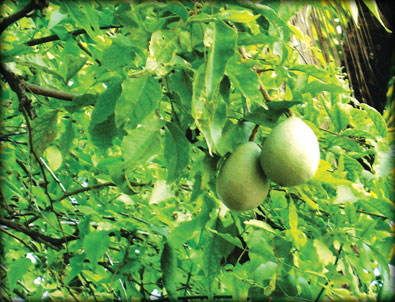The delightful Beli fruit
by Shari Jayawardhana
 Bael (Aegle marmelos) is a fruit-bearing tree indigenous to dry
forests on hills and plains of the Indian Subcontinent. It is popularly
known as Beli (Sinhala) and Vilyam Palam (Tamil). The tree is the only
species in the genus Aegle and grows up to 18 metres in height and bears
thorns and fragrant flowers. Bael belongs to the same family as the
orange. It has a woody-skinned, smooth fruit 5-15 cm in diametre. The
bael fruit has numerous seeds, which are densely covered with fibrous
hairs and are embedded in a thick, gluey, aromatic pulp. Bael (Aegle marmelos) is a fruit-bearing tree indigenous to dry
forests on hills and plains of the Indian Subcontinent. It is popularly
known as Beli (Sinhala) and Vilyam Palam (Tamil). The tree is the only
species in the genus Aegle and grows up to 18 metres in height and bears
thorns and fragrant flowers. Bael belongs to the same family as the
orange. It has a woody-skinned, smooth fruit 5-15 cm in diametre. The
bael fruit has numerous seeds, which are densely covered with fibrous
hairs and are embedded in a thick, gluey, aromatic pulp.
The fruit can be eaten fresh or dried. If fresh, the juice is
strained and sweetened to make a drink. It is also used in making a
refreshing drink where the pulp is mixed with tamarind. The bael tree is
considered to be a sacred tree for Hindus as Lord Shiva is said to live
under the bael tree. It is quite common to observe bael trees in Hindu
temple gardens in Sri Lanka.
The fruit
The bael fruit takes about 11 months to ripen on the tree and can
reach the size of a large grapefruit. The shell of the fruit is so hard
that it must be cracked open with a hammer. The fibrous yellow pulp of
the fruit is very aromatic and has been known to taste like marmalade
and smell like a rose. The bael fruit is used in traditional Sri Lankan
Ayurveda for the treatment of diarrhoea. Bael also has a high tannin
content which makes it an effective cure for dysentery and cholera. Bael
fruit can be taken for reducing constipation as the flesh of the fruit
is believed to possess laxative properties. Taking ripe fruit everyday
for about two-three months can eliminate acute and sub-chronic
constipation. The pulp is used in the treatment of Vitiligo.
The bael fruit has the ability to heal small ulcers inside the bowel
which are produced by infection or inflammation. Beli fruit is a very
good source of vitamins B1, B2 and it has a considerable amount of
protein. The bael fruit is one of the most nutritious fruits, rich in
riboflavin and used for the preparation of a number of products like
candy, squash toffee, slab, pulp powder and nectar.
The Beli fruit is used for treatment of diarrhoea, dysentery, worms,
ulcerative colitis, diabetes, chronic fever, nausea, vomiting,
gastritis, enteritis and bleeding disorders. In Sri Lanka, the ripe
fruit, with coconut milk, sugar and salt is often used in the treatment
of haemorrhoids. Artists use the fruit pulp for their water colour, and
it may be applied as a protective coating on paintings. In rural Sri
Lanka, the fruit, which has binding qualities, is mixed with lime
plaster for water proofing wells and is added to cement for building
walls in villages.
The leaf
Bael leaves are extremely useful for treating diabetes, jaundice,
cholera and asthma. Bael leaves are made into a poultice and used in the
treatments of ophthalmia. Bael Leaf is applied to inflammations, it is
also a good treatment for catarrh and fever. The leaf juice, mixed in
warm water with a little pepper, is given as a drink to bring relief
from wheezing and respiratory spasm.
The leaf of the bael tree has been effective in reducing blood
glucose level by 54 percent. It has also found to be beneficial in
decreasing the blood cholesterol levels controlling the triglyceride,
serum and tissue lipid profiles.
The leaf extracts showed to be effective in combating many bacterial
strains. Apart from bacteria, bael extracts were also effective in
controlling fungal and viral infections. The antimicrobial properties
are due to the presence of biochemicals such as cuminaldehyde and
eugenol. The leaves also have pesticide properties in them. Leaf
decoction is effective for burning sensation in the body, thirst and
vomiting. The leaf is used to prepare herbal wines that treat thirst,
burning sensation, vomiting, gastritis and morning sickness.
The flower
The flowers of the bael tree are greenish white and fragrant. In Sri
Lanka, the flowers and buds are sun dried and boiled in water and served
as herbal tea. This refreshing brew is said to regulate the digestive
system and has a cooling effect on the body. The bael flowers aid in
increasing apatite, reducing thirst and helps prevent vomiting,
diarrhoea and indigestion. It is also known to relieve gastric pains,
reduce stomach acid and enhance bowel movement and reduce constipation.
The decoction of the flowers is used as eye lotion. Cologne is
extracted by distillation from the flowers. The bael tree occupies an
important place among traditional medicine in Sri Lanka. It is one of
religious importance and one that consists of many therapeutic
properties. The most popular value added product manufactured in Sri
Lanka, using bael is herbal teas. These herbal teas are gaining
popularity in Sri Lanka and abroad.
Why not try a bael herbal tea for yourself and experience the
difference. |

